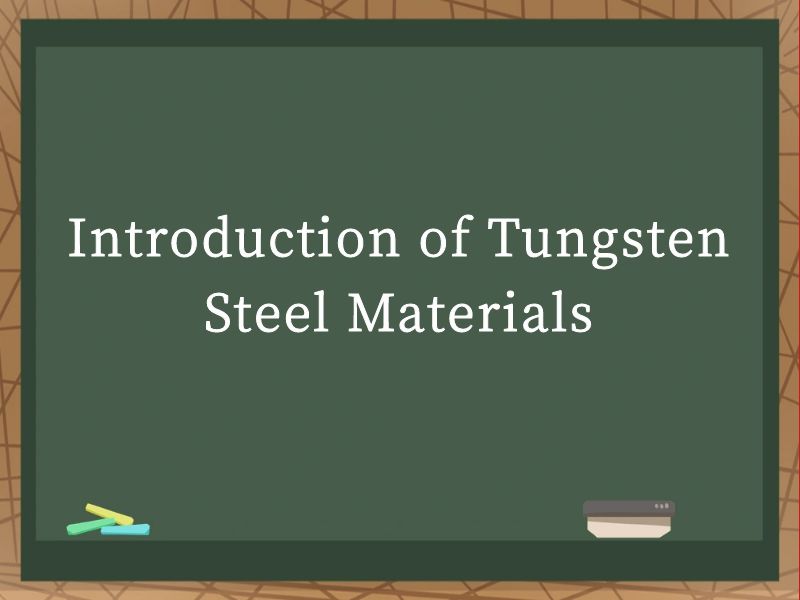JOURNALISM
- NEWS -
|
Introduction of Tungsten Steel MaterialsIntroduction of Tungsten Steel Materials.Tungsten steel, often referred to as high-speed steel or tungsten alloy steel, stands as a remarkable material in the realm of engineering and industrial applications. Its unique blend of properties makes it indispensable in a wide array of sectors, ranging from tool manufacturing to aerospace technology. This intricate metal combines the hardness and wear resistance of tungsten with the toughness and machinability of steel, resulting in a material that is both versatile and robust.
The history of tungsten steel dates back to the late 19th century when scientists began experimenting with alloy combinations to enhance the performance of cutting tools. Tungsten, a rare metal discovered in Sweden in 1783, was initially used in its pure form for its hardness. However, it was the realization that combining tungsten with steel could yield a material with superior characteristics that propelled its use into the industrial age. The development of tungsten steel was a significant milestone, marking a transition from traditional tool materials to more advanced, high-performance alloys. The fundamental composition of tungsten steel includes a significant percentage of tungsten carbide (WC), which is responsible for its hardness and wear resistance. Tungsten carbide is a ceramic compound formed by the combination of tungsten and carbon under high temperatures. This compound is embedded in a matrix of steel, typically containing cobalt, nickel, or iron, which provides the alloy with its toughness and ductility. The exact composition of tungsten steel can vary depending on the intended application, with some alloys containing up to 90% tungsten carbide for maximum hardness and others balancing hardness and toughness for broader usability. One of the most notable characteristics of tungsten steel is its exceptional hardness. On the Mohs scale of hardness, tungsten carbide ranges between 8.5 and 9, making it one of the hardest materials available. This hardness translates into exceptional wear resistance, allowing tungsten steel tools to retain their sharpness and cutting edges for extended periods. This is particularly advantageous in applications such as drilling, milling, and turning, where tools are subjected to constant wear and tear. In addition to its hardness, tungsten steel also exhibits high thermal stability. This means that it retains its hardness and strength at elevated temperatures, making it ideal for high-temperature applications. In cutting tools, for instance, the friction generated during the cutting process can cause significant heat build-up. Tungsten steel's ability to maintain its properties at these high temperatures ensures that the tool remains effective and does not degrade rapidly. The manufacturing process of tungsten steel involves several complex steps. Initially, tungsten ore is mined and refined to extract pure tungsten. This tungsten is then combined with carbon in a high-temperature furnace to form tungsten carbide. The resulting tungsten carbide powder is mixed with a binder metal, such as cobalt, to create a homogeneous mixture. This mixture is then pressed into the desired shape under high pressure and sintered in a furnace at temperatures ranging from 1200°C to 1500°C. The sintering process fuses the particles together, creating a dense and strong alloy. Post-sintering, the tungsten steel parts may undergo additional processing steps, such as grinding, polishing, and coating, to achieve the final desired specifications. These steps are crucial for enhancing the surface finish, improving dimensional accuracy, and adding additional properties such as corrosion resistance. The versatility of tungsten steel is evident in its wide range of applications. In the tool and die industry, tungsten steel is used to manufacture cutting tools, drills, milling cutters, and dies. These tools are essential for shaping and machining metals, plastics, and other materials. The hardness and wear resistance of tungsten steel ensure that these tools can operate efficiently for long periods, reducing downtime and maintenance costs. In the aerospace industry, tungsten steel is used in components that require high strength and resistance to high temperatures. Turbine blades, engine nozzles, and other critical parts often incorporate tungsten steel alloys to ensure reliability and durability in extreme conditions. The thermal stability of tungsten steel makes it particularly suitable for these applications, as it can withstand the high temperatures and stresses associated with aerospace operations. The automotive industry also benefits from the use of tungsten steel. In engine components, such as valves and bearings, tungsten steel provides the necessary hardness and wear resistance to withstand the rigorous conditions of internal combustion engines. This contributes to improved engine performance, longer component lifespan, and reduced maintenance requirements. In addition to its industrial applications, tungsten steel is also used in the medical field. Surgical instruments, such as scalpels and drills, are often made from tungsten steel due to its ability to maintain a sharp edge and resist corrosion. The biocompatibility of tungsten steel also makes it suitable for implantable medical devices, such as orthopedic implants and dental prosthetics. Despite its numerous advantages, tungsten steel does have some limitations. Its high hardness and wear resistance can make it difficult to machine and form into complex shapes. This requires specialized equipment and techniques to ensure accurate and efficient processing. Furthermore, the high cost of tungsten and the complex manufacturing process contribute to the overall price of tungsten steel products, limiting their use in some cost-sensitive applications. Research and development in tungsten steel continue to push the boundaries of what is possible with this remarkable material. Advances in alloy composition and manufacturing techniques are yielding new grades of tungsten steel with enhanced properties. For example, the development of nanostructured tungsten steel alloys is yielding materials with improved toughness and machinability. These alloys incorporate tungsten carbide particles at the nanoscale, which results in a more uniform distribution and better bonding with the matrix metal. Another area of research is the development of coatings for tungsten steel. Coatings such as titanium nitride (TiN) and aluminum oxide (Al2O3) can be applied to the surface of tungsten steel tools to improve their wear resistance, reduce friction, and enhance their performance in specific applications. These coatings can be applied using techniques such as physical vapor deposition (PVD) and chemical vapor deposition (CVD), which allow for precise control over the coating thickness and composition. Environmental considerations are also becoming increasingly important in the production and use of tungsten steel. The mining and refining of tungsten ore can have significant environmental impacts, including habitat destruction and pollution. Efforts are being made to develop more sustainable mining and refining practices, as well as to recycle tungsten steel scrap to reduce waste. In conclusion, tungsten steel is a versatile and robust material with a wide range of applications in engineering and industrial sectors. Its exceptional hardness, wear resistance, and thermal stability make it ideal for cutting tools, aerospace components, automotive parts, and medical devices. As research and development continue to advance, new grades and coatings for tungsten steel will further expand its use and improve its performance in various applications. Despite its limitations, tungsten steel remains an indispensable material in the modern industrial landscape, driving innovation and progress in numerous fields. |


